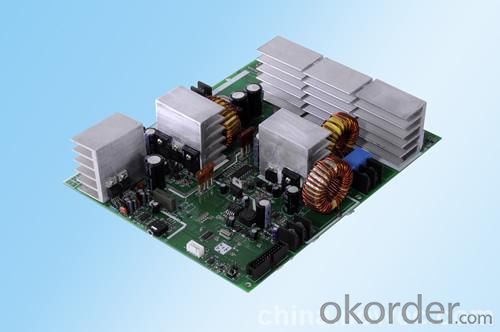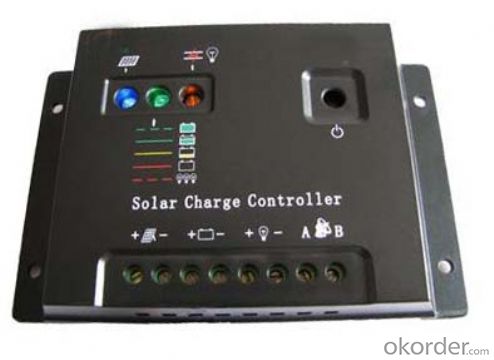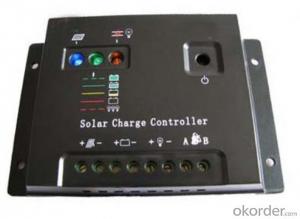Solar Charge Controller
- Loading Port:
- China Main Port
- Payment Terms:
- TT OR LC
- Min Order Qty:
- -
- Supply Capability:
- -
OKorder Service Pledge
Quality Product, Order Online Tracking, Timely Delivery
OKorder Financial Service
Credit Rating, Credit Services, Credit Purchasing
You Might Also Like
Specifications
CE certified.suitable for home use and solar street light use, time control and light control with temperature sensor.
Solar Controller
1.Multi protections, Factory price
2.Self-consumption:6mA, Big terminals:4mm2
3.2 years guarantee
4.CE,RoHS
solar one charge controller, top two in China. CE certified, stable performance, stable production capacity. Most popular goods for exporting. Especailly widely used in Solar system from 50W to 5kw.


- Q:Can a solar controller be used with solar-powered ventilation systems?
- Yes, a solar controller can be used with solar-powered ventilation systems. The solar controller regulates the flow of power from the solar panels to the ventilation system, ensuring optimal performance and efficient utilization of solar energy. It helps control the voltage and current supplied to the ventilation system, preventing overcharging or undercharging of the batteries, and maximizing the system's overall effectiveness.
- Q:How do I protect a solar controller from power surges?
- To protect a solar controller from power surges, you can take a few precautionary measures: 1. Install a surge protector: Consider adding a surge protector device specifically designed for solar systems. These devices are installed between the solar panels and the solar controller, acting as a barrier against power surges. They help divert excessive voltage and prevent it from damaging the controller. 2. Grounding: Ensure that your solar system is properly grounded. Grounding provides a path for the excess electrical energy to discharge safely into the ground, reducing the risk of damage to the solar controller. Consult with a professional electrician or follow the manufacturer's guidelines to ensure proper grounding. 3. Lightning protection: Lightning strikes can cause severe power surges, so it's crucial to have proper lightning protection measures in place. Install lightning rods or conductive systems that direct the lightning strike safely to the ground, away from the solar controller and other equipment. 4. Regular maintenance and inspections: Conduct regular inspections of your solar system to identify any damage or potential issues. Check for loose connections, corroded wires, or any signs of wear and tear that may increase the vulnerability to power surges. Promptly repair or replace any damaged components to prevent further damage. 5. Consider an overvoltage protection device: Another option is to install an overvoltage protection device (OVPD) specifically designed for solar systems. OVPDs monitor the voltage levels and disconnect the solar panels from the controller when the voltage exceeds a safe threshold. This helps protect the controller from power surges and excessive voltage. Remember that while these measures can greatly reduce the risk of damage from power surges, they may not provide 100% protection. In extreme cases, such as severe lightning strikes, it's still possible for some damage to occur. Therefore, it's important to have appropriate insurance coverage and consult with professionals for proper installation and protection measures.
- Q:Can a solar controller be used with solar street lights?
- Yes, a solar controller can be used with solar street lights. A solar controller, also known as a charge controller, is an essential component in a solar power system that regulates the flow of electricity from the solar panels to the batteries. It ensures that the batteries are charged efficiently and prevents overcharging or damage to the batteries. In the case of solar street lights, a solar controller is necessary to control the charging and discharging of the batteries that power the lights. It helps to maximize the performance and lifespan of the batteries, ensuring that the solar street lights operate effectively and reliably.
- Q:How do I calculate the required solar panel capacity for a solar controller?
- To calculate the required solar panel capacity for a solar controller, you need to consider two main factors: the power consumption of your load and the amount of sunlight available in your location. First, determine the power consumption of your load by adding up the wattage of all the devices or appliances you plan to connect to the solar controller. This will give you the total power requirement in watts. Next, consider the amount of sunlight available in your location. This can vary depending on factors such as the season, latitude, and weather conditions. You can find solar insolation data for your area from reputable sources or consult with a solar professional. Once you have the power requirement and solar insolation data, divide the total power requirement by the average daily solar insolation to get the required solar panel capacity in watts. It's advisable to add a safety margin of around 10-20% to account for any inefficiencies or variations. Keep in mind that solar panels have a rated capacity in watts, so you may need to round up to the nearest available panel size. Additionally, consider other factors such as the battery capacity and charge controller efficiency in your overall solar system design.
- Q:Can a solar controller be used with flexible solar panels?
- Yes, a solar controller can be used with flexible solar panels. Solar controllers are designed to regulate the charging process of solar panels, regardless of their flexibility. As long as the flexible solar panel is compatible with the solar controller's voltage and current ratings, it can be used effectively.
- Q:How do I maintain a solar controller?
- To effectively maintain a solar controller, it is crucial to follow several important steps: 1. Conduct regular inspections of the controller itself, searching for any signs of damage or wear. Look out for loose connections, frayed wires, or any other visible issues. If any problems are detected, address them promptly to prevent further damage. 2. Keep the solar controller clean by gently wiping the surface with a soft cloth or using a brush. Over time, dust, dirt, and debris can accumulate on the controller, diminishing its efficiency. Avoid using harsh chemicals or abrasive materials that might harm the controller. 3. Ensure that all connections between the solar panels, battery, and load are secure and properly tightened. Loose connections can cause power loss and inefficiency. In case of any loose or corroded connections, tighten them or replace them if necessary. 4. Regularly inspect the battery if your solar controller is connected to one. Monitor the battery voltage and ensure it remains within the recommended range. A significant drop in voltage may indicate a problem with the controller or the battery itself. 5. If applicable, check for firmware updates. Some solar controllers can be updated to enhance performance or address bugs or issues. Refer to the manufacturer's instructions or website to see if any firmware updates are available and follow the provided instructions to update the controller as needed. 6. Protect the solar controller from extreme temperatures. These controllers are designed to operate within specific temperature ranges, and extreme heat or cold can impact their performance or cause damage. Whenever possible, install the solar controller in a location that offers protection from extreme temperatures. 7. Lastly, it is essential to adhere to the manufacturer's guidelines and instructions for specific maintenance recommendations related to your solar controller model. Different controllers may have unique maintenance requirements, so following the manufacturer's guidelines is vital to ensure proper care and prolong the lifespan of your solar controller.
- Q:Can a solar controller be used with a solar-powered water purification system?
- Yes, a solar controller can be used with a solar-powered water purification system. A solar controller is responsible for regulating the amount of power being generated by solar panels and ensuring that it is optimized for the system's needs. In a solar-powered water purification system, the solar controller would help manage the power supply to the purification components, such as pumps or filters, ensuring efficient operation and maximizing the use of solar energy.
- Q:Can a solar controller be used with a solar hybrid system?
- Yes, a solar controller can be used with a solar hybrid system. The solar controller regulates the flow of energy between the solar panels, battery storage, and the grid, ensuring optimal performance and efficient energy management in a hybrid system.
- Q:How does a solar controller prevent over-discharging of batteries?
- A solar controller prevents over-discharging of batteries by constantly monitoring the battery voltage and automatically disconnecting the load when the battery reaches a certain voltage threshold. This prevents the battery from being drained below its recommended capacity, which can lead to irreversible damage and reduced lifespan.
- Q:How to adjust the solar controller
- Battery status indication: When the battery voltage is in the normal range, the status indicator (2) is green; if the status indicator is green slow flashing; when the battery voltage drops to undervoltage, the status indicator turns orange; when the battery When the voltage continues to decrease to the overdischarge voltage, the status indicator (2) turns red, and the controller will automatically turn off the output to remind the user to replenish the power in time. When the battery voltage returns to normal operating range, the output enable operation is automatically enabled and the status indicator (2) turns green
1. Manufacturer Overview |
|
|---|---|
| Location | |
| Year Established | |
| Annual Output Value | |
| Main Markets | |
| Company Certifications | |
2. Manufacturer Certificates |
|
|---|---|
| a) Certification Name | |
| Range | |
| Reference | |
| Validity Period | |
3. Manufacturer Capability |
|
|---|---|
| a)Trade Capacity | |
| Nearest Port | |
| Export Percentage | |
| No.of Employees in Trade Department | |
| Language Spoken: | |
| b)Factory Information | |
| Factory Size: | |
| No. of Production Lines | |
| Contract Manufacturing | |
| Product Price Range | |
Send your message to us
Solar Charge Controller
- Loading Port:
- China Main Port
- Payment Terms:
- TT OR LC
- Min Order Qty:
- -
- Supply Capability:
- -
OKorder Service Pledge
Quality Product, Order Online Tracking, Timely Delivery
OKorder Financial Service
Credit Rating, Credit Services, Credit Purchasing
Similar products
New products
Hot products
Hot Searches
Related keywords






























